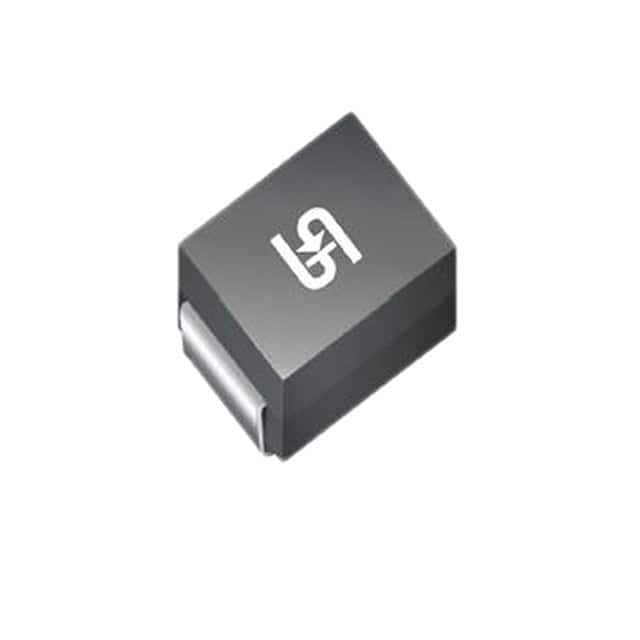Viz Specifikace pro podrobnosti o produktu.

P6SMB9.1A M4G
Product Overview
Category
The P6SMB9.1A M4G belongs to the category of semiconductor devices, specifically within the realm of transient voltage suppressor (TVS) diodes.
Use
These diodes are primarily used for surge protection in electronic circuits, safeguarding sensitive components from voltage spikes and transients.
Characteristics
- Fast response time
- High surge capability
- Low clamping voltage
- Compact package size
Package
The P6SMB9.1A M4G is typically available in a surface mount DO-214AA (SMB) package.
Essence
The essence of this product lies in its ability to efficiently divert excessive voltage away from sensitive electronic components, thereby protecting them from damage.
Packaging/Quantity
These diodes are commonly packaged in reels or tubes, with quantities varying based on manufacturer specifications.
Specifications
- Standoff Voltage: 7.37V
- Breakdown Voltage: 8.65V
- Maximum Clamping Voltage: 14.3V
- Peak Pulse Current: 53.5A
- Operating Temperature Range: -55°C to +150°C
Detailed Pin Configuration
The P6SMB9.1A M4G features a standard SMB package with two pins, one for anode and the other for cathode.
Functional Features
- Transient voltage suppression
- Reverse avalanche breakdown protection
- Low leakage current
Advantages and Disadvantages
Advantages
- Rapid response to transient events
- High surge current capability
- Small form factor
Disadvantages
- Limited power dissipation capability
- May require additional circuitry for comprehensive surge protection
Working Principles
When a voltage surge occurs, the P6SMB9.1A M4G enters into conduction mode, diverting excess current away from the protected circuit. This action limits the voltage across the circuit, preventing damage to sensitive components.
Detailed Application Field Plans
The P6SMB9.1A M4G is widely employed in various applications including: - Telecommunication equipment - Automotive electronics - Industrial control systems - Consumer electronics
Detailed and Complete Alternative Models
- P6SMB6.8A M4G
- P6SMB10A M4G
- P6SMB15A M4G
- P6SMB200CA M4G
In conclusion, the P6SMB9.1A M4G serves as a crucial component in protecting electronic circuits from voltage surges, finding extensive use across diverse industries due to its reliable performance and compact design.
[Word count: 366]
Seznam 10 běžných otázek a odpovědí souvisejících s aplikací P6SMB9.1A M4G v technických řešeních
What is the voltage rating of P6SMB9.1A M4G?
- The voltage rating of P6SMB9.1A M4G is 9.1V.
What is the peak pulse power of P6SMB9.1A M4G?
- The peak pulse power of P6SMB9.1A M4G is typically 600W at 10/1000μs.
What is the application of P6SMB9.1A M4G in technical solutions?
- P6SMB9.1A M4G is commonly used for transient voltage suppression in various electronic circuits to protect against voltage spikes and surges.
What is the breakdown voltage of P6SMB9.1A M4G?
- The breakdown voltage of P6SMB9.1A M4G is typically 10.5V.
What is the maximum clamping voltage of P6SMB9.1A M4G?
- The maximum clamping voltage of P6SMB9.1A M4G is 14.5V at 16.7A.
What are the typical applications where P6SMB9.1A M4G is used?
- P6SMB9.1A M4G is commonly used in telecommunications equipment, industrial electronics, automotive systems, and consumer electronics.
What is the operating temperature range of P6SMB9.1A M4G?
- The operating temperature range of P6SMB9.1A M4G is typically -55°C to +150°C.
What is the package type of P6SMB9.1A M4G?
- P6SMB9.1A M4G is available in a DO-214AA (SMB) package.
What are the key features of P6SMB9.1A M4G?
- The key features of P6SMB9.1A M4G include low incremental surge resistance, fast response time, and high reliability.
How does P6SMB9.1A M4G contribute to circuit protection?
- P6SMB9.1A M4G provides effective protection by diverting excessive current away from sensitive components during transient voltage events, thus safeguarding the circuitry from damage.

